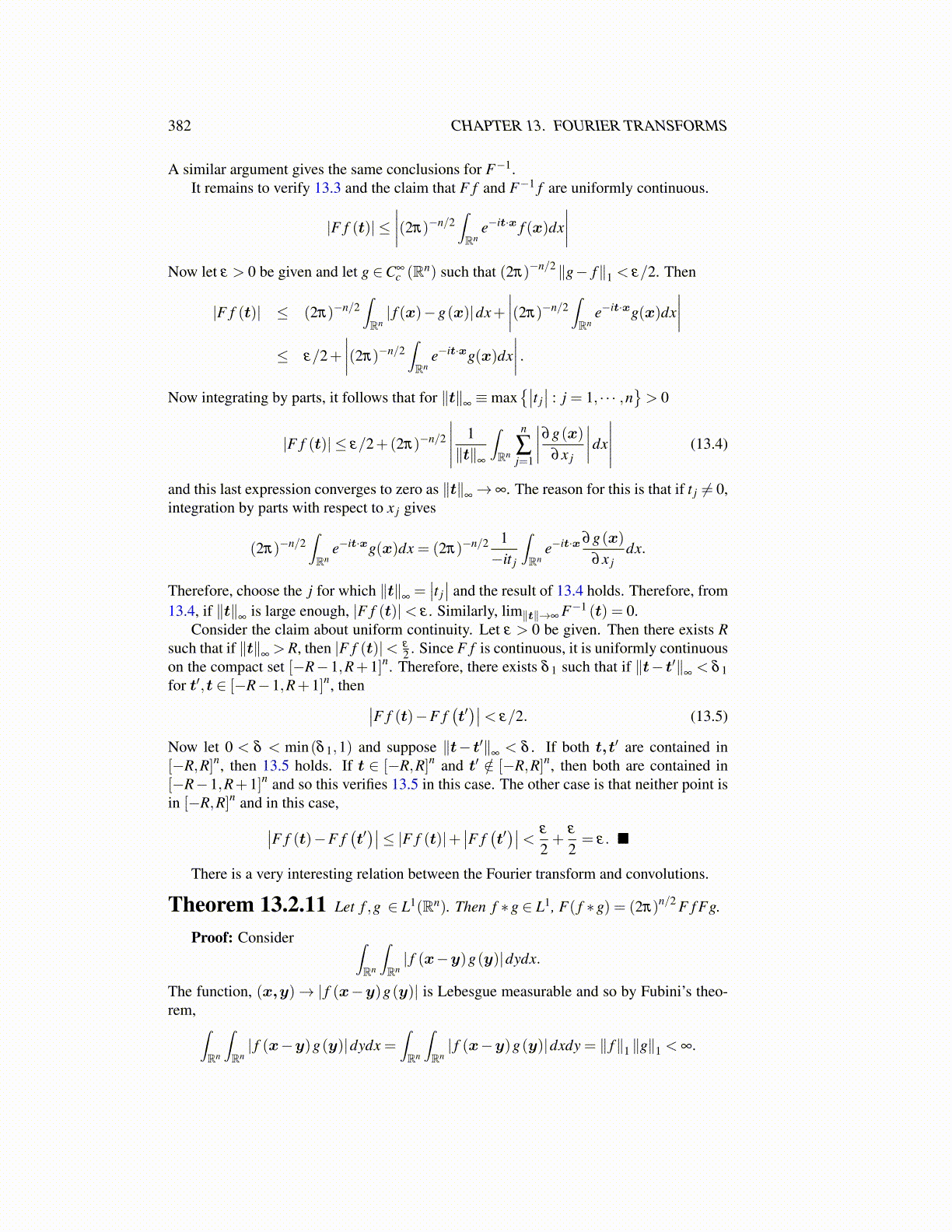
382 CHAPTER 13. FOURIER TRANSFORMS
A similar argument gives the same conclusions for F−1.It remains to verify 13.3 and the claim that F f and F−1 f are uniformly continuous.
|F f (t)| ≤∣∣∣∣(2π)−n/2
∫Rn
e−it·x f (x)dx∣∣∣∣
Now let ε > 0 be given and let g ∈C∞c (Rn) such that (2π)−n/2 ∥g− f∥1 < ε/2. Then
|F f (t)| ≤ (2π)−n/2∫Rn| f (x)−g(x)|dx+
∣∣∣∣(2π)−n/2∫Rn
e−it·xg(x)dx∣∣∣∣
≤ ε/2+∣∣∣∣(2π)−n/2
∫Rn
e−it·xg(x)dx∣∣∣∣ .
Now integrating by parts, it follows that for ∥t∥∞≡max
{∣∣t j∣∣ : j = 1, · · · ,n
}> 0
|F f (t)| ≤ ε/2+(2π)−n/2
∣∣∣∣∣ 1∥t∥
∞
∫Rn
n
∑j=1
∣∣∣∣∂g(x)∂x j
∣∣∣∣dx
∣∣∣∣∣ (13.4)
and this last expression converges to zero as ∥t∥∞→∞. The reason for this is that if t j ̸= 0,
integration by parts with respect to x j gives
(2π)−n/2∫Rn
e−it·xg(x)dx = (2π)−n/2 1−it j
∫Rn
e−it·x ∂g(x)∂x j
dx.
Therefore, choose the j for which ∥t∥∞=∣∣t j∣∣ and the result of 13.4 holds. Therefore, from
13.4, if ∥t∥∞
is large enough, |F f (t)|< ε . Similarly, lim∥t∥→∞ F−1 (t) = 0.Consider the claim about uniform continuity. Let ε > 0 be given. Then there exists R
such that if ∥t∥∞> R, then |F f (t)|< ε
2 . Since F f is continuous, it is uniformly continuouson the compact set [−R−1,R+1]n. Therefore, there exists δ 1 such that if ∥t− t′∥
∞< δ 1
for t′,t ∈ [−R−1,R+1]n, then ∣∣F f (t)−F f(t′)∣∣< ε/2. (13.5)
Now let 0 < δ < min(δ 1,1) and suppose ∥t− t′∥∞< δ . If both t,t′ are contained in
[−R,R]n, then 13.5 holds. If t ∈ [−R,R]n and t′ /∈ [−R,R]n, then both are contained in[−R−1,R+1]n and so this verifies 13.5 in this case. The other case is that neither point isin [−R,R]n and in this case,∣∣F f (t)−F f
(t′)∣∣≤ |F f (t)|+
∣∣F f(t′)∣∣< ε
2+
ε
2= ε. ■
There is a very interesting relation between the Fourier transform and convolutions.
Theorem 13.2.11 Let f ,g ∈ L1(Rn). Then f ∗g ∈ L1, F( f ∗g) = (2π)n/2 F f Fg.
Proof: Consider ∫Rn
∫Rn| f (x−y)g(y)|dydx.
The function, (x,y)→ | f (x−y)g(y)| is Lebesgue measurable and so by Fubini’s theo-rem, ∫
Rn
∫Rn| f (x−y)g(y)|dydx =
∫Rn
∫Rn| f (x−y)g(y)|dxdy = ∥ f∥1 ∥g∥1 < ∞.